
The present Northwest Texas Conference came into being in 1910 out of the old Northwest Texas Conference.
Northwest Texas History written by: Darris L. Egger, Conference Historian
That conference was established in 1866 and extended from south of Waco northwestward to all the Panhandle. The present NW Texas Conference extends from Abilene on the south, Midland on the West, and Vernon on the northeast, and then to the top of the Panhandle.
Albany is the oldest existing church in the Conference, having been organized in 1873, a year before Shackelford County was organized. The first district in the present Conference was Belle Plaine, which lasted only three years, 1881-1883. The Abilene District came into being in 1883 and is still going strong. The “Pan Handle” District was also created in 1880, but lasted only one year.
The Vernon District was established in 1888, and until 1894, when the Clarendon District was formed. The Abilene and Vernon Districts administered all the work in what would become the Northwest Texas Conference. In 1904 the Colorado District was organized and known as “The Jumbo District” extending all the way north to Tulia and west to the New Mexico line. The year 1906 saw the creation of the Plainview District, and the Stamford District was formed soon after 1908.
When the huge Conference was divided into the Central Texas and the present Northwest Texas Conference in 1910, the latter had six districts: Abilene, Clarendon, Colorado, Plainview, Stamford and Vernon. At the first session of the new Conference, three new districts were added: Amarillo, Big Spring and Hamlin. Throughout the 85-year-old history, there have been new alignments in districts and name changes made, but all covering the same territory as in 1910.
Through dedicated lay and clergy, the Northwest Texas Conference has attempted to carry the Gospel to the 66 countries within its boundaries, to the nation and the world. This has been done with missionary zeal and mission dollars, by evangelistic fervor, through higher Christian education. The Methodist zeal for Christian higher education was manifested by the establishment of five colleges: Belle Paine, Seth Ward, Clarendon, Stamford and McMurry. Only McMurry succeeded in the struggle for existence and has since become a university.
In addition, Wesley Foundations have provided Christian campus ministries at Texas Tech and West Texas A&M. Youth camps at Ceta Canyon Camp and Butman Methodist Camp and Retreat Center, Youth Assemblies at McMurry, the ministry of healing at Methodist Hospital in Lubbock and in its affiliates throughout West Texas and Eastern New Mexico, and Golden Cross are only a few of our channel of ministry.
Local churches are where ministries begin and take place. None could have happened without local church interest and commitment. Sunday Schools teaching the age-old truths, pastors in pulpits challenging people to live the Christian imperative, have fueled the work of the church in the world.
This is a “bare bones sketch” of the history of the Northwest Texas Conference.
Darris L. Egger, Conference Historian
McMurry University
The NWTX Archives are now on display at McMurry University.
Our physical archives host over 100 years of church history, journals, church historical plates, saddle bags, and more! Mrs. Cindy Martin, St. John’s UMC laity, was the last archivist for the NWTX Conference and did a fantastic job overseeing the collection and sending it to McMurry with the closing of the NWTX Conference Service Center.
-
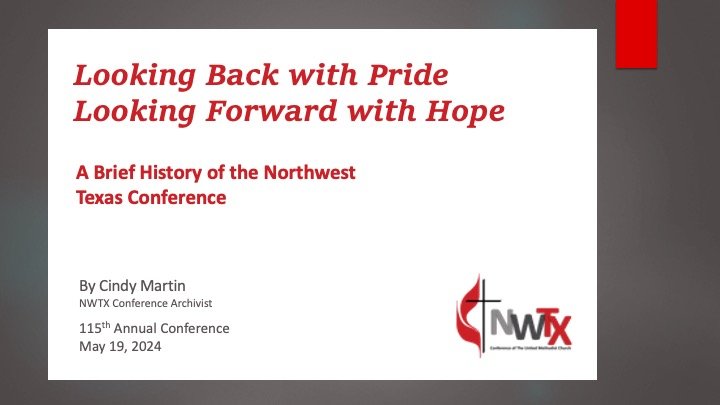
May 19, 2024, celebrates the 115th session of the Northwest Texas Conference and the last annual conference as the NWTX conference. A lot of people don’t think archives and history are important. Thankfully, Methodists do. They consider the keeping of history a Ministry of Memory. One of the 5 areas of mission focus in the unification plan is Tell Our Story – and our history falls within that mission focus. Here is the Northwest Texas Conference story – a short version, anyway.
-

We date our conference from 1910, but its history really reaches back to the 1870s. The original Northwest Texas conference stretched northwestward from Georgetown and Waco – it was the conference of the Texas frontier.
-

In September 1873, Bishop George Pierce issued an unusual call for preachers to serve: “The dainty, the timid, have no business here. The rides are long, the fare plain—the exposure in wind and weather very great, often severe—pay scanty . . . . Who will volunteer?”
-

Forty-six-year-old Levi Collins answered the Bishop’s call. His first assignment was Ft. Griffin and there, Collins preached the first Methodist sermon in what would become our Northwest Texas conference.
-

As people moved into the vast prairies and ranchland of West Texas Methodism mirrored the population’s migration and a handful of dedicated preachers carried the gospel to wherever the people were. As one county historian noted, “By the time the settler was unloaded and cozy in his modest cabin, a Methodist circuit rider was knocking on the door.”
-

In 1881 Peter Gravis and James Hosmer attempted to win over the cowboys at Mobeetie after first being scared away by the violence and many saloons.
-

In 1892 a young pastor, Ed Wallace was hoping to be reappointed to familiar grounds in Eastland Texas but instead was appointed to Floyd and Briscoe. He was pleased when he thought he had been elevated to two churches but then learned that he was to be the only preacher in the two counties - 35 by 70 miles. It would require more than 100 miles of traveling to 14 preaching points. He had indeed been “elevated” to the high plains of Northwest Texas.
-

These early pioneer preachers exhibited great courage by taking on a vast territory – on horseback, buggy and bicycle and on foot and even swam flooded rivers to ensure that the gospel would be preached. Some sacrificed any hope of wealth, and to a large extent their families, to answer God’s call.
-

Circuit rider Cal C. Wright (ordained in 1909) said of those days, “We were in tune with God. The witness of the Spirit continued with us. Methodism grew mightily.”
-
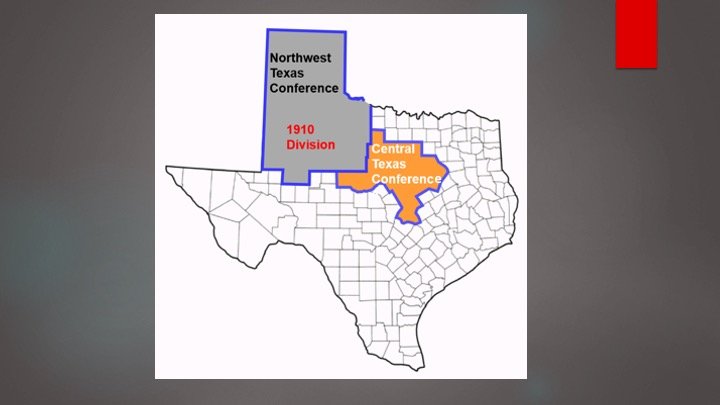
By the early 1900s the conference was the state’s largest geographically and numerically. As a result, in 1910 it was divided into the Central Texas Conference and a new Northwest Texas Conference.
-
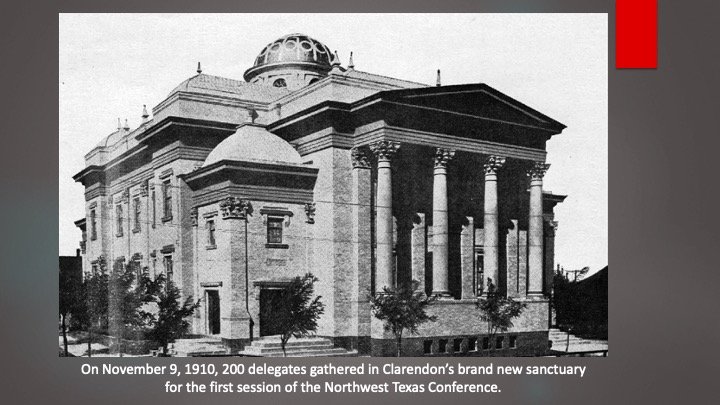
In November 1910, two hundred delegates gathered in Clarendon’s brand-new sanctuary for the first session of the new Northwest Texas Conference.
-
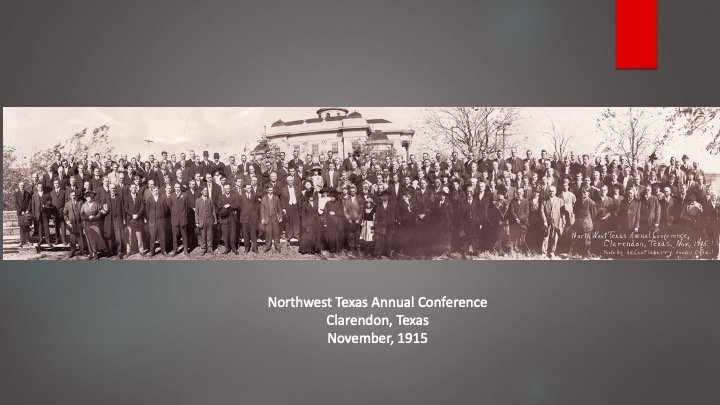
The conference listed membership at 35,099 in 415 churches with 189 churches having their own buildings.
-

Evangelism was a hallmark of the early years with revivals held every summer. In 1920 Bishop W. F. McMurry reported that 367 churches had held revivals resulting in 9,500 conversions.
-

But the conference was also focused on education as well. Methodists took the lead in establishing educational institutions to serve the region. The Church established Belle Plain College in 1881.
-

Other Methodist schools included Clarendon College, 1898, Stamford College at Stamford, 1907, Seth Ward at Plainview, 1910, and McMurry in 1923 (and it’s still going strong).
-

Disastrous fires closed both Seth Ward and Stamford colleges in the mid-teens.
-

In its early years conference-wide organizations were established. The Women’s Missionary Society was formed in 1911 and continues today as United Women in Faith. A men’s organization was founded in 1922 and The Epworth League for youth first met in Vernon in 1916.
-

During the ‘30s, the drought and depression took a toll with donations down dramatically and the population of the region declining, but the conference gained 10,000 new members during the period.
-

With the growth TTC and WT State Teachers College, the Women’s Missionary Society sought ways to minister to Methodist students first by teaching Bible classes and then by encouraging the establishment of Wesley Foundations, accomplished at both campuses in the 1930s.
-

After World War II, most new churches were established to serve the growing suburban populations of Amarillo, Lubbock, Plainview, Abilene, and Midland. Even older churches grew in the 1950s. The postwar “baby boom,” prompted new parents to seek churches in order to get religious training for their children. The 1950s became the decade of the church in America, and especially in the Northwest Texas Conference.
-
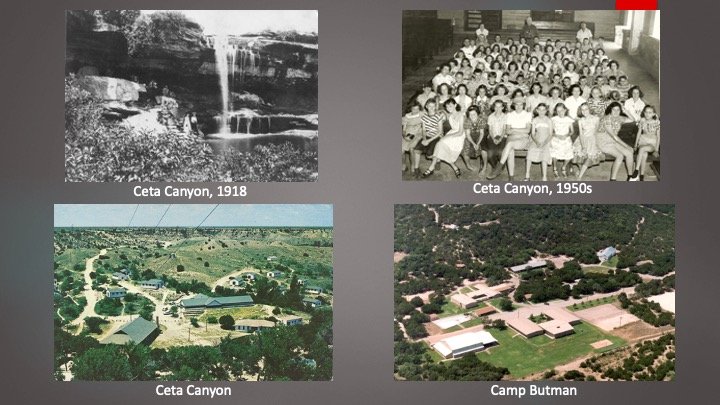
To serve these growing churches, the Conference expanded its camping program. The Ceta Canyon camp near Palo Duro Canyon, with beginnings dating to 1916, was hosting more than 4,000 annually by 1950. In 1953, Methodists accepted the donation from Sam Butman to create a second camp site in Mulberry Canyon west of Abilene.
-

In 1954, the Conference also accepted the donation and debt of the Lubbock Memorial Hospital, and renamed it Methodist Hospital, Lubbock, a name it bore for more than 40 years before merging with the owners of St. Mary’s to become Covenant Hospital System. Later the conference would recognize the needs of an aging population by creating Homes for Older Adults: King’s Manor in Hereford, Sears Memorial Methodist Center in Abilene (later expanded as Sears Methodist Retirement System).
-
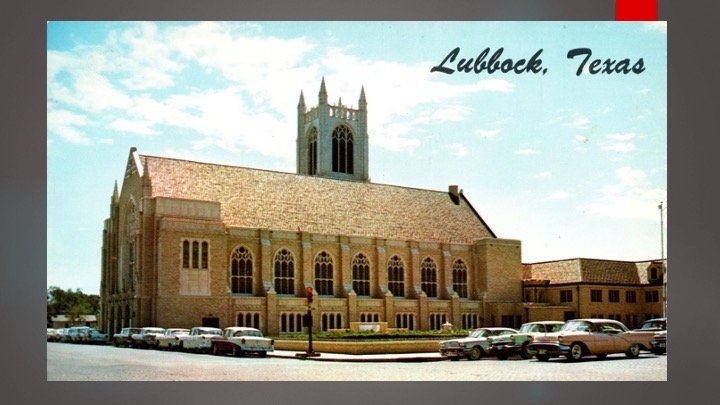
By the 1950s, the Northwest Texas Conference had become the shining star of the American Methodist conferences with its strong infrastructure—two summer camps, a first-class new hospital, and 328 churches with a total membership over 100,000. Lubbock’s First Methodist Church’s new Cathedral of the West became symbolic of the Conference’s strength. Moreover, membership growth had kept pace with the region’s population.
-

However, the numbers masked a growing problem. In the 1950s, rural churches began closing at an alarming rate—more than 4 per year—as members either died or moved away. And, by the early 1960s, baptisms and Sunday School enrollment sharply dropped. By the mid-1960s, the membership of the Northwest Texas Conference, as well as the national church, peaked, and then began a long slow decline.
-

The causes for the change were numerous and complex. The ’60s saw the entire region drop in population by more than 50,000, and its sixty-two rural counties lost nearly 11 percent of their population. And in the words of Bob Dylan, the times they were a changing. The 1960s and 70s brought tremendous social change to the US which led to a decline in church attendance. Other forms of religious expression, such as the charismatic movement, also began to draw members away from mainline Protestant churches. The NWTX conference experienced a general shift toward a more conservative approach to theological and social issues.
The first woman was ordained in the conference in 1965 and in 1968 the union of the Methodist Church with the Evangelical United Brethren brought five churches of the black Central Jurisdiction into the NWTX conference.
-

Beginning in the late 1970s the conference focused resources on and encouraged support of African American and Hispanic churches. The conference supported Lubbock’s Interethnic Parish, a community center in Amarillo, the service center in Abilene and there was continued emphasis on missions with active volunteers in missions programs in addition to continued support to more traditional programs such as the Lydia Patterson Institute. Church plants brought new additions to the conference.
-
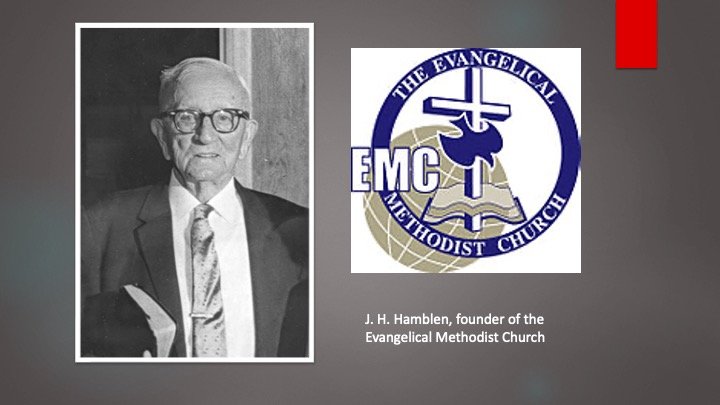
But, of course, our conference has obviously not been without controversy. We’ve seen it recently. But we’ve been through it before. Not every Northwest Texas Methodist embraced the 1939 unification of northern and southern Methodists and formed a new denomination called the Southern Methodist Church. In 1945, J. H. Hamblen the popular pastor of the First Methodist Church of Abilene and a leader in the conference (onetime presiding elder, DS) was concerned about Methodism’s embrace of “modernism” in the seminaries and colleges and SS literature. With some fanfare he ended up leaving the conference and founding the Evangelical Methodist Church. We’ve had controversy over camp, how to deal with the pandemic. And then of course, years of controversy more or less leading to disaffiliations.
-

The centennial history of this conference is named “And Are We Yet Alive?”, the title of Charles Wesley’s great hymn the call to worship at the first and many NWTX conference assemblies through the years. The question seems more relevant now than ever after a pandemic, disaffiliation, and issues facing society and the world. We find great hope in the fact that Methodists have always drawn strength from one another thanks to the historic connectional system.
-
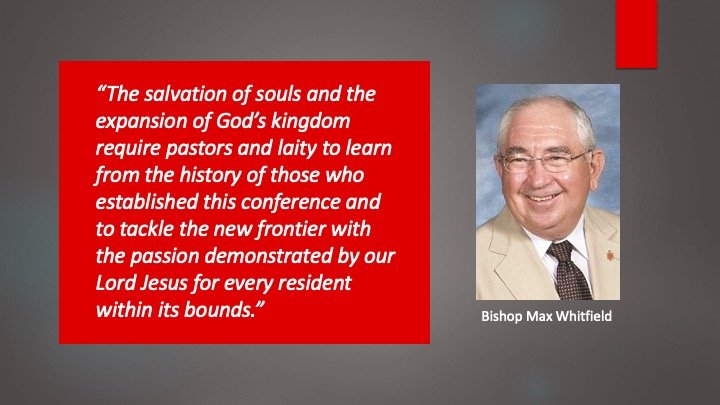
In his forward to the centennial history Bishop Max Whitfield advised that “The salvation of souls and the expansion of God’s kingdom require pastors and laity to learn from the history of those who established this conference and to tackle the new frontier with the passion demonstrated by our Lord Jesus for every resident within its bounds.”
-
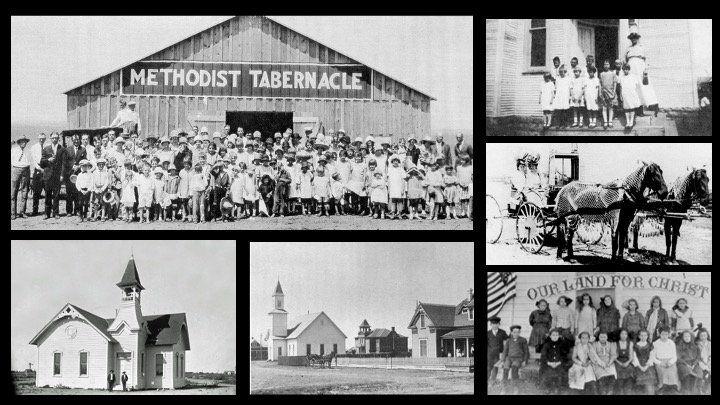
Let the stories and experiences of those who established and led this conference through the years be an inspiration and guide as we advance into this new, perhaps unknown territory – this new frontier.





